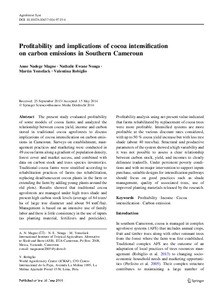| dc.contributor.author | Magne, A.N. |
| dc.contributor.author | Nonga, N.E. |
| dc.contributor.author | Yemefack, M. |
| dc.contributor.author | Robiglio, V. |
| dc.date.accessioned | 2019-12-04T11:03:27Z |
| dc.date.available | 2019-12-04T11:03:27Z |
| dc.date.issued | 2014-06 |
| dc.identifier.citation | Magne, A.N., Nonga, N.E., Yemefack, M. & Robiglio, V. (2014). Profitability and implications of cocoa intensification on carbon emissions in Southern Cameroun. Agroforestry Systems, 88(6), 1133-1142. |
| dc.identifier.issn | 0167-4366 |
| dc.identifier.uri | https://hdl.handle.net/20.500.12478/1076 |
| dc.description.abstract | The present study evaluated profitability of some models of cocoa farms and analyzed the relationship between cocoa yield, income and carbon stored in traditional cocoa agroforests to discuss implications of cocoa intensification on carbon emissions in Cameroun. Surveys on establishment, management practices and marketing were conducted in 49 cocoa farms along a gradient of population density, forest cover and market access, and combined with data on carbon stock and trees species inventories. Traditional cocoa farms were stratified according to rehabilitation practices of farms (no rehabilitation, replacing dead/senescent cocoa plants in the farm or extending the farm by adding young plants around the old plots). Results showed that traditional cocoa agroforests are managed under high trees shade and present high carbon stock levels (average of 64 trees/ha of large tree diameter and about 94 tonC/ha). Management is based on an intensive use of family labor and there is little consistency in the use of inputs (as planting material, fertilizers and pesticides). Profitability analysis using net present value indicated that farms rehabilitated by replacement of cocoa trees were more profitable. Intensified systems are more profitable at the various discount rates considered, with up to 50 % cocoa yield increase but with less tree shade (about 40 trees/ha). Structural and productive parameters of the system showed a high variability and it was not possible to assess a clear relationship between carbon stock, yield, and incomes to clearly delineate tradeoffs. Under persistent poverty conditions and with no major intervention to support inputs purchase, suitable designs for intensification pathways should focus on good practices such as shade management, quality of associated trees, use of improved planting materials released by the research. |
| dc.language.iso | en |
| dc.subject | Cocoa (Plant) |
| dc.subject | Profitability |
| dc.subject | Income |
| dc.title | Profitability and implications of cocoa intensification on carbon emissions in southern Cameroun |
| dc.type | Journal Article |
| dc.description.version | Peer Review |
| cg.contributor.affiliation | International Institute of Tropical Agriculture |
| cg.contributor.affiliation | World Agroforestry Centre |
| cg.coverage.region | Africa |
| cg.coverage.region | Central Africa |
| cg.coverage.country | Cameroon |
| cg.isijournal | ISI Journal |
| cg.authorship.types | CGIAR and advanced research institute |
| cg.iitasubject | Cocoa |
| cg.journal | Agroforestry Systems |
| cg.howpublished | Formally Published |
| cg.accessibilitystatus | Limited Access |
| local.dspaceid | 78074 |
| cg.identifier.doi | https://dx.doi.org/10.1007/s10457-014-9715-4 |

